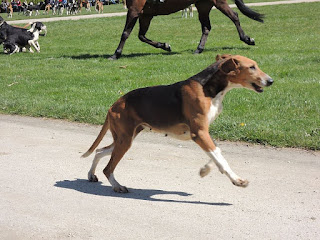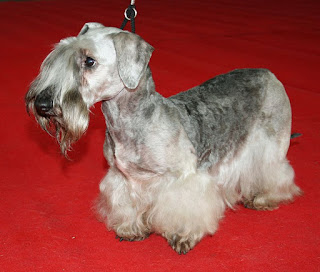The
Chihuahua is the smallest breed of dog
and is named after the state of Chihuahua in Mexico. Chihuahuas come in a wide
variety of colors, and two coat lengths.
Description
Chihuahuas
are the smallest breed recognized by some kennel clubs.
There
are two varieties of Chihuahua – the Smooth Coat (shorthaired) and the Long
Coat (longhaired). Both the Smooth and the Long Coats have their special
attractions and are equally easy to keep clean and well groomed. The UK Kennel
Club considers smooth and long coat Chihuahuas two distinct breeds; matings
between the two are not eligible for KC registration.
Dogs
of either coat type may be identified as either "apple head" or
"deer head" Chihuahuas, particularly in the United States. Apple
heads have rounded heads, close-set eyes, and relatively short ears and legs.
Deer heads have flat-topped heads, more widely set eyes, larger ears, and
longer, more slender legs. While deer heads were popular in the mid-twentieth
century, current breed standards defined by registries such as the American
Kennel Club specify the apple head conformation.
Appearance
Breed
standards for this dog do not generally specify a height; only a weight and a
description of their overall proportions. Generally, the height ranges between
15 and 23 cm (6 and 9 in); however, some dogs grow as tall as 30 to 38 cm (12
to 15 in). Both British and American breed standards state that a Chihuahua
must not weigh more than 2.7 kg (6 lb) for conformation. However, the British
standard also states that a weight of 1.8–2.7 kg (4–6 lb) is preferred. A
clause stating that 'if two dogs are equally good in type, the more diminutive
one is preferred' was removed in 2009. The Fédération Cynologique
Internationale (FCI) standard calls for dogs ideally between 1.5 and 3.0 kg
(3.3 and 6.6 lbs.), although smaller ones are acceptable in the show ring.
Pet
Chihuahuas (that is, those bred or purchased as companions rather than show
dogs) often range above these weights, even above ten pounds if they have large
bone structures or are allowed to become overweight. This does not mean that
they are not purebred Chihuahuas; they just do not meet the requirements to
enter a conformation show. Oversized Chihuahuas are seen in some of the best,
and worst, bloodlines. Chihuahuas do not breed true for size, and puppies from
the same litter can mature drastically different sizes from one another. As
well, larger breeding females are less likely to experience dystocia
(obstructed labor). Typically, the breed standard for both the long and short
coat Chihuahua will be identical except for the description of the coat.
Chihuahuas have large, round eyes and large, erect ears, set in a high,
dramatically rounded skull.
The
Kennel Club in the United Kingdom and the American Kennel Club in the United
States recognize only two varieties of Chihuahua: the long coat, and the smooth
coat, also referred to as longhaired and shorthaired. They are genetically the
same breed. The term smooth coat does not mean that the hair is necessarily
smooth, as the hair can range from having a velvet touch to a whiskery feeling.
Longhaired Chihuahuas are actually smoother to the touch, having soft, fine
guard hairs and a downy undercoat, which gives them their fluffy appearance.
Unlike many longhaired breeds, longhaired Chihuahuas require no trimming and
minimal grooming. Contrary to popular belief, the longhaired breed also
typically sheds less than its shorthaired counterparts. It may take up to three
or more years before a full longhaired coat develops.
Chihuahuas
come in virtually any color combination, from solid to marked or splashed,
allowing for colors from solid black to solid white, spotted, sabled, or a
variety of other colors and patterns. Colors and patterns can combine and
affect each other, resulting in a very high degree of variation. Common colors
are fawn, red, cream, chocolate, brown, mixed, white, and black. No color or
pattern is considered more valuable than another.
The
merle coat pattern, which appears mottled, is not traditionally considered part
of the breed standard. In May 2007, The Kennel Club decided not to register
puppies with this coloration due to the health risks associated with the
responsible gene, and in December of that year formally amended the Breed
Standard to disqualify merle dogs. The Fédération Cynologique Internationale,
which represents the major kennel clubs of 84 countries, also disqualified
merle. Other countries' kennel clubs, including Canada, Australia, New Zealand,
and Germany, have also disqualified merle. However, in May 2008, the Chihuahua
Club of America voted that merles would not be disqualified in the United
States, and would be fully registrable and able to compete in American Kennel
Club (AKC) events. Opponents of merle recognition suspect the coloration came
about by modern crossbreeding with other dogs and not via natural genetic
drift.[citation needed]
Temperament
How
a Chihuahua behaves depends on the genetic temperament of his or her parents
and grandparents. However, as with all dogs, socialization and training are
very important. Like many small dogs, Chihuahuas are less likely than large
dogs to be given obedience classes, socialization, or appropriate exercise and
training. Frequent victims of "small dog syndrome," in which owners
feel no need to provide the kind of training and socialization routinely
provided for larger dogs, untrained Chihuahuas suffer the same predictable
behavior problems as other untrained dogs regardless of the breed. However,
they thrive well when given appropriate socialization and training.
Poorly
socialized or frightened Chihuahuas can be easily provoked to attack, and are
therefore generally unsuitable for homes with small and undisciplined children.
The breed tends to be fiercely loyal to one particular person and in some cases
may become over protective of the person, especially around other people or
animals. They are frequently not introduced to or socialized with dogs of other
breeds, and as a result do not interact as well with them as other dogs who
have been socialized to interact with different breed types and tend to have a
"clannish" nature, often preferring the companionship of other
Chihuahuas or Chihuahua mixes over other dogs. These traits generally make them
unsuitable for households with children who are not patient and calm. If properly
managed by older children, 13 and up, they can adapt to this kind of living
with a dedicated owner. The temperament of its owner can make a difference in
the temperament of the pup.
Chihuahuas
love their dens and will often burrow themselves in pillows, clothes hampers,
and blankets. They are often found under the covers or at the bottom of the
bed, deep in the dark and safety of what they perceive as their den. Chihuahuas
also enjoy time in sunlight.
Health
This
breed requires expert veterinary attention in areas such as birthing and dental
care. Dental care is a must for these small dogs, whose jaw size makes for
weaker teeth. Although daily brushing provides the best preventative measure,
feeding a dental diet or using dental chews for dogs is an effective approach
pet owners can take to help prevent and control accumulation of plaque and
tartar to avoid consequences of severe periodontal disease. The best physical
characteristics of dog food to contribute to cleaning a dog's teeth would be
food that is large and dense, that way there is more time spent chewing which
leads to the surface of the teeth being cleaned.
Chihuahuas,
and other toy breeds, can be affected by hydrocephalus. Chihuahua puppies with
hydrocephalus have an abnormally large head, are lethargic and do not grow at
the same pace as their siblings. A true case of hydrocephalus can be diagnosed
by a veterinarian, though the prognosis is grim.
Apple
head Chihuahuas can have moleras, or a soft spot in their skulls, and they are
the only breed of dog to be born with an incomplete skull. This is not a
defect; it is a normal adaptation facilitating the passage through the birth
canal and growth and development of the domed type of forehead. The molera is
predominant in the apple heads and is present in nearly all Chihuahua puppies.
The molera fills in with age, but great care needs to be taken during the first
six months until the skull is fully formed. Some moleras do not close
completely and require extra care to prevent injury.
Chihuahua
puppies can be at risk for hypoglycemia, or low blood sugar. Signs of
hypoglycemia include lethargy, sleepiness, uncoordinated walking, unfocused
eyes and spasms of the neck muscles or head pulling back or to the side,
fainting and seizures. Hypoglycemia can be avoided with adequate nutrition and
frequent feedings, especially for Chihuahuas who are younger, smaller or
leaner. Chihuahua owners should have a simple sugar supplement on hand to use
in emergencies, such as Nutri-Cal or original formula Karo syrup. These
supplements can be rubbed on the gums and roof of the mouth to rapidly raise
the blood sugar level.
On
the other hand, as with any dog, owners should take care not to overfeed their
Chihuahua, since obesity can result in increased rates of joint injuries,
tracheal collapse, chronic bronchitis, and shortened life span.
As
in other breeds with large protruding eyes, Chihuahuas are prone to eye
infections or eye injury. The eyes may water in response to dry air, dust or
air-borne allergens.
Collapsed
trachea is a health concern that is characteristic of the Chihuahua breed.
Chihuahuas
may tremble or shiver when stressed, excited or cold. Chihuahuas, especially
the short coat variety, are less tolerant of cold than larger breeds, and
require a sweater and/or boots in cold weather. They will seek warmth in
sunshine, under blankets, or on furniture, or human laps.
Some
Chihuahuas may present separation anxiety as a result of being so close and loyal
to their owner. This is a fairly common cause behind any pacing, excessive
salivating, destructive chewing, or barking, howling or whining in dogs. There
are many treatments and tips to help prevent separation anxiety in dogs.
The
average lifespan for a Chihuahua is between 12 and 20 years.
Chihuahuas
are also known for luxating patella, a genetic condition that can occur in all
dogs. In some dogs, the ridges forming the patellar groove are not shaped
correctly and a shallow groove is created, causing the patella to luxate or
slip out of place, sideways. The knee cap sliding across the bony ridges of the
femur can cause some pain. The affected chihuahua will hold its leg flexed, and
foot off the ground until the quadriceps muscle relaxes and lengthens, after
which the animal feels no discomfort and continues with activity.
Chihuahuas
are also prone to some heart-related disorders, such as heart murmurs and
pulmonic stenosis, a condition in which the blood outflow from the heart's
right ventricle is obstructed at the pulmonic valve.












